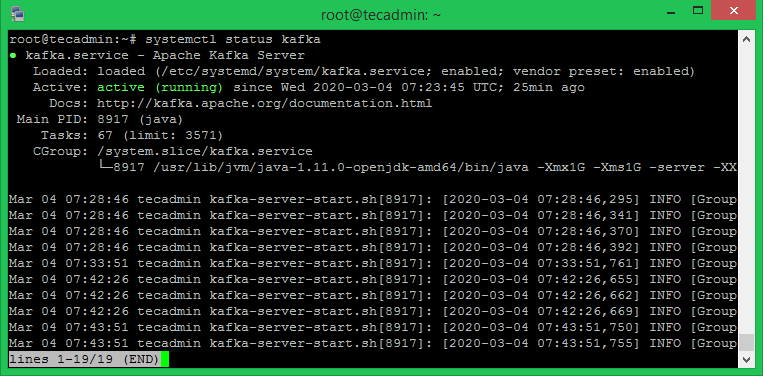Apache Kafka is an open-source, distributed event streaming platform developed by the Apache Software Foundation. This is written in Scala and Java programming languages. You can install Kafka on any platform supported Java.
This tutorial described you step by step tutorial to install Apache Kafka on Ubuntu 20.04 LTS Linux system. You will also learn to create topics in Kafka and run producer and consumer nodes.
Prerequisites
You must have sudo privileged account access to the Ubuntu 20.04 Linux system.
Step 1 – Installing Java
Apache Kafka can be run on all platform supported Java. In order to setup Kafka on Ubuntu system, you need to install java first. As we know, the Oracle java is now commercially available, So we are using its open source version OpenJDK.
Execute below command to install OpenJDK on your system from the official PPA’s.
sudo apt update sudo apt install default-jdk
Verify the current active Java version.
java --version
openjdk version "11.0.9.1" 2020-11-04
OpenJDK Runtime Environment (build 11.0.9.1+1-Ubuntu-0ubuntu1.20.04)
OpenJDK 64-Bit Server VM (build 11.0.9.1+1-Ubuntu-0ubuntu1.20.04, mixed mode, sharing)
Step 2 – Download Latest Apache Kafka
Download the Apache Kafka binary files from its official download website. You can also select any nearby mirror to download.
wget http://www-us.apache.org/dist/kafka/2.7.0/kafka_2.13-2.7.0.tgz
Then extract the archive file
tar xzf kafka_2.13-2.7.0.tgz mv kafka_2.13-2.7.0 /usr/local/kafka
Step 3 – Creating Systemd Unit Files
Now, you need to create systemd unit files for the Zookeeper and Kafka services. Which will help you to start/stop Kafka service in easy way.
First, create a systemd unit file for Zookeeper:
vim /etc/systemd/system/zookeeper.service
And add the following content:
[Unit] Description=Apache Zookeeper server Documentation=http://zookeeper.apache.org Requires=network.target remote-fs.target After=network.target remote-fs.target [Service] Type=simple ExecStart=/usr/local/kafka/bin/zookeeper-server-start.sh /usr/local/kafka/config/zookeeper.properties ExecStop=/usr/local/kafka/bin/zookeeper-server-stop.sh Restart=on-abnormal [Install] WantedBy=multi-user.target
Save the file and close it.
Next, to create a systemd unit file for the Kafka service:
vim /etc/systemd/system/kafka.service
Add the below content. Make sure to set the correct JAVA_HOME path as per the Java installed on your system.
[Unit] Description=Apache Kafka Server Documentation=http://kafka.apache.org/documentation.html Requires=zookeeper.service [Service] Type=simple Environment="JAVA_HOME=/usr/lib/jvm/java-1.11.0-openjdk-amd64" ExecStart=/usr/local/kafka/bin/kafka-server-start.sh /usr/local/kafka/config/server.properties ExecStop=/usr/local/kafka/bin/kafka-server-stop.sh [Install] WantedBy=multi-user.target
Save file and close.
Reload the systemd daemon to apply new changes.
systemctl daemon-reload
Step 4 – Start Kafka and Zookeeper Service
First, you need to start ZooKeeper service and then start Kafka. Use systemctl command to to start single-node ZooKeeper instance.
sudo systemctl start zookeeper
Now start the Kafka server and view the running status:
sudo systemctl start kafka sudo systemctl status kafka
All done. The Kafka installation has been successfully completed. The part of this tutorial will help you to work with the Kafka server.
Step 5 – Create a Topic in Kafka
Kafka provides multiple pre-built shell script to work on it. First, create a topic named “testTopic” with a single partition with single replica:
cd /usr/local/kafka bin/kafka-topics.sh --create --zookeeper localhost:2181 --replication-factor 1 --partitions 1 --topic testTopic Created topic testTopic.
The replication-factor describes how many copies of data will be created. As we are running with a single instance keep this value 1.
Set the partitions options as the number of brokers you want your data to be split between. As we are running with a single broker keep this value 1.
You can create multiple topics by running the same command as above. After that, you can see the created topics on Kafka by the running below command:
bin/kafka-topics.sh --list --zookeeper localhost:2181 [output] testTopic
Alternatively, instead of manually creating topics you can also configure your brokers to auto-create topics when a non-existent topic is published to.
Step 6 – Send and Receive Messages in Kafka
The “producer” is the process responsible for put data into our Kafka. The Kafka comes with a command-line client that will take input from a file or from standard input and send it out as messages to the Kafka cluster. The default Kafka sends each line as a separate message.
Let’s run the producer and then type a few messages into the console to send to the server.
bin/kafka-console-producer.sh --broker-list localhost:9092 --topic testTopic >Welcome to kafka >This is my first topic >
You can exit this command or keep this terminal running for further testing. Now open a new terminal to the Kafka consumer process on the next step.
Step 7 – Using Kafka Consumer
Kafka also has a command-line consumer to read data from the Kafka cluster and display messages to standard output.
bin/kafka-console-consumer.sh --bootstrap-server localhost:9092 --topic testTopic --from-beginning Welcome to kafka This is my first topic
Now, If you have still running Kafka producer (Step #6) in another terminal. Just type some text on that producer terminal. it will immediately visible on consumer terminal. See the below screenshot of Kafka producer and consumer in working:
Conclusion
This tutorial helped you to install and configure Apache Kafka service on an Ubuntu system. Additionally, you learned to create a new topic in Kafka server and run a sample production and consumer process with Apache Kafka.
The post How to Install Apache Kafka on Ubuntu 20.04 appeared first on TecAdmin.




